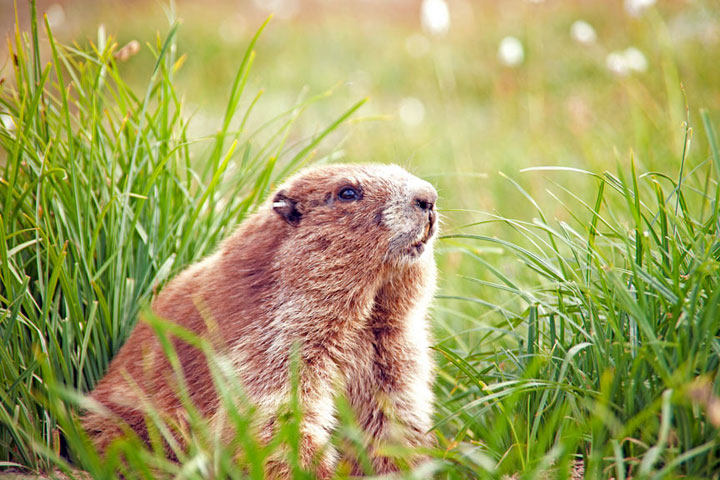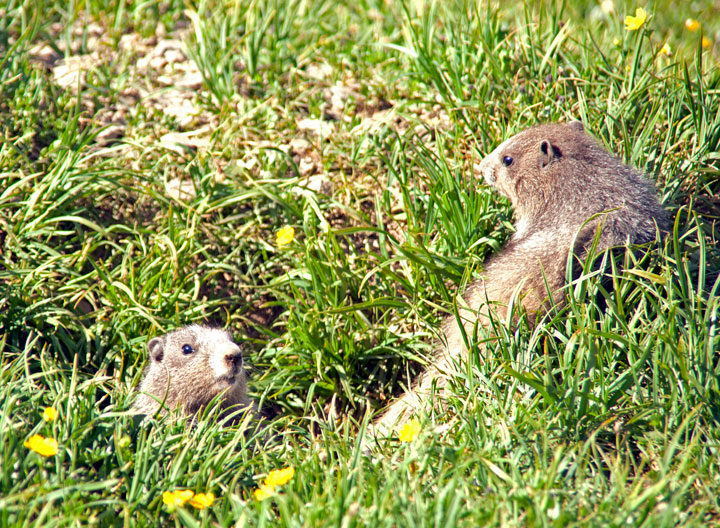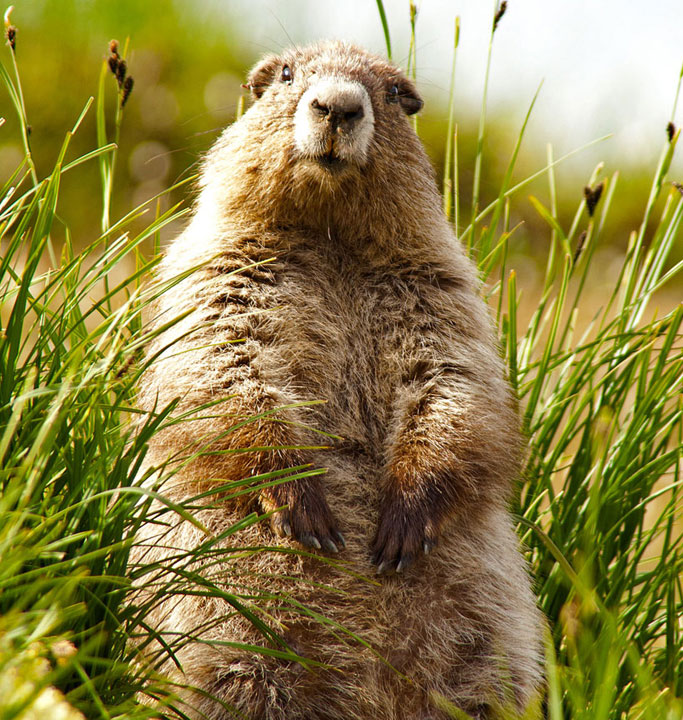
Olympic Marmot Adult
This is one of my favorite times of the year. Summer has finally arrived in the Olympic mountains and the sub-alpine meadows are an array of vibrant and fragrant wildflowers. The timing was perfect but my plan for photographing the flowers took a backseat when this furry marmot family on the windswept mountain slope captured my heart and my camera lens.
Marmots are members of the squirrel family, prairie dogs and squirrels are its closest relatives. The endemic Olympic marmot is the second rarest of the North American marmots, it’s coat, voice and chromosome number differing from other marmots. Living in burrows at high elevations marmots hibernate for up to eight months of the year. Their body temperature drops to <40 degrees Fahrenheit and their heart to 3 beats per minute (in comparison a bear’s body temp during hibernation doesn’t drop below 88 degrees). Every 10 days or so they do warm their body but don’t eat or drink during this time.
Pups
A burrow can be home to a single marmot or more than a dozen. Female marmots reach sexual maturity at age 3 yet the average age of first reproduction is 4.5 years of age. They give birth to 1-6 pups every other year, with only half of the pups surviving the first year. A typical family of marmots, called a colony, consists of a male, two to three females, and their young, sometimes living in groups of more than a dozen animals. Young marmots stay with their family for at least two years, so a burrow is often home to a newly born litter and a year-old litter.
YearlingIf you look closely you can see the ear-tags on the adults. Marmots have been documented in the Olympic high country since the Press, ONeil, and other expeditions began recording the fauna of these mountains in the 1880s. During the 1950’s they were hunted for food and sport but managed to maintain a fairly healthy population until until the late the 1990’s. Suddenly park rangers and long-time visitors noticed the absence of marmots in areas where they once flourished. In 2002 ear-tagging and monitoring began to determine the reason for the marmots alarming decline. From the studies it appears the predation on adult females by coyotes is the culprit. Coyotes were uncommon in the high country until recently and many believe global warming maybe the reason, warmer weather allowing the coyote to exist at higher elevations. Coupled with the marmots unusually slow life-history raises concern over its future.
It was a real treat for me to spend several late afternoons sitting near this marmot family’s home watching as they carried on their daily activities. Maybe I’ll get another chance to visit this family before the snow starts to fly and they descend into their burrow for a long winter’s nap. And I hope next summer they’ll still be there and new pups will be playing alongside their mother.
Thanks for reading.
Nancy Cherry Eifert
- Fawn in Ferns
- Gray Squirrel in Cherry Tree
- Young Doe and Woodpile
- Our Little Campground Host
- Luminosity – Peonies
- Peony – A love Affair
- Miller Peninsula State Park – Beach Trail via Fireweed Road
- Iris Duo
- Dosewallip Dance
- Dosewallips River Valley Hike
- Cooper’s hawk in our pond
- Northern Pygmy Owl
- American Pika
- My Photos on Exhibit in the Port Townsend Carnegie Library
- Another successful Wooden Boat Festival
- One of my Photos in 48 North Magazine
- Tulips, Highland Cows and Trumpeter Swans
- Celebrating Spring
- My Owl Buddies
- Celebrating Dia de los Muertos at Seattle Center
- Point Reyes National Seashore
- Brightwork and Bliss
- Ptarmigans and Marmots
- The Olympic Marmot
- Wooden Boat Festival!
- Capitol Campus
- New Show in Gallery Nine for June
- Dosewallips (doh’-si-wall-ips) River Hike
- Sidonie’s Cooking Classes
- Meet Sekiu
- Seattle Aquarium’s Furry Miracle
- Ho! Ho! Ho! Happy Holidays to All!
- Autumn – Cool Days…Cooler Nights
- Alaska & Brown Bears
- Autumn in Alaska
- Crazy gray haired lady arrested for trespassing…almost!
- Bark Shanty Bridge

